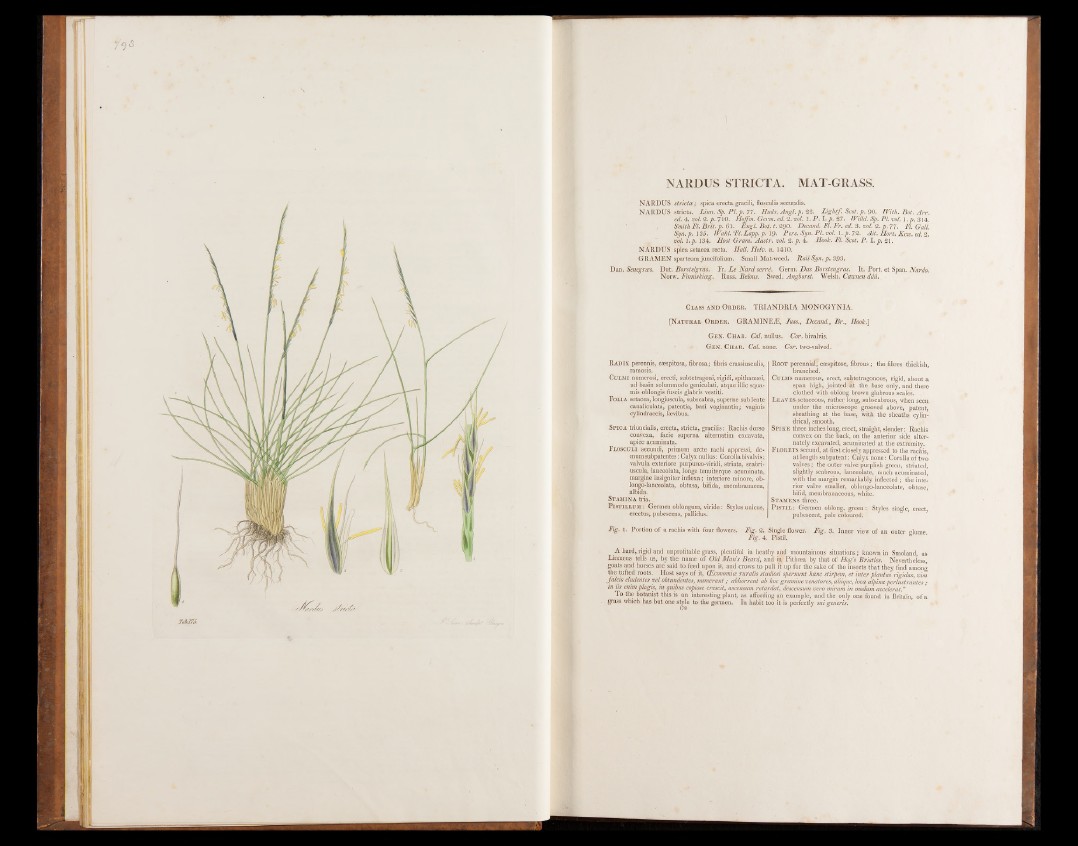
/j/nc& r,
NARDUS STRICTA. MAT-GRASS.
NARDUS stricta; spica erecta gracili, flosculis securjdis.
NARDUS stricta. Linn. Sp. PI. p. 77. Huds. Angl.p. 22. L ig h t/ Scot. p. 90. With. Bot. Arr.
cd. 4. ml. 2. p. 710. Hoffm. Germ. ed. 2. ml. 1. P . I. p. 27. Willd. Sp. PI. ml. 1. p. 3 14 .
, Smith Fl. Brit. p. 6 1. Engl. Bot. t. 2,90. Decand. Fl. Fr. ed. 3. ml. 2. p .77. FI. Gall.
Syn. p. 135. Wahl. *Fl. Lapp. p . ï9 . Pers. Syn. P I. ml. \ .p . 72. A it. Hort. Kexo. ed. 2.
ml. \.p . 134. Host Gram. Austr. ml. 2. p. 4. Hook. Fl. Scot. P. I. p. 21.
NARDUS spica setacea recta. Hall. Helv. n. 1410.
GRAMEN sparteum juncifolium. Small Mat-weed. R a n Syn. p. 393.
Dan. Senegras. Dut. Borstelgras. Fr. L e Ndrd serré. Germ. Das Borstengras. It. Port. et Span. Nardo.
Norw. Fimiskiceg. Russ. Belous. Swed. Angborst. Welsh. Cazvnen ddü. . •
Class a n d O r d e r . TRIA N D RIA MONOGYNIA.
[N a tu r a l Or d e r . GRAMINEÆ, Juss., Decand., Br., Hook.]
G e n . Ch a r . Cal. nullus. Cor. bivalvis.
G e n . Ch a r . Cal. none. Cor. two-valved.
Ra d ix perennis, cæspitosa, fibrosa; fi bris crassiusculis,
ramosis.
Culmi numerosi, erecti, subtetragoni, rigidi, spithamæi,
ad basin solummodo geniculati, atque illic squa-
mis oblongis fuscis glabris vestiti.
Folia setacea, longiuscula, subscabra, superne sub lente
canaliculata, patentia, basi vaginantia; vaginis
cylindraceis, lævibus.
Sp ic a triuncialis, erecta, stricta, gracilis : Rachis dorso
convexa, facie superna alternatim excavata,
apice acuminata.
Flosculi secundi, primum arcte rachi appressi, de-
mum subpatentes: Calyx nullus: Corolla bivalvis;
valvula exteriore purpureo-viridi, striata, scabri-
uscula, lanceolata, longe tenuiterque acuminata,
margine insigniter inflexa ; interiore minore, ob-
. longo-lanceolata, obtusa, bifida, membranacea,
albida.
St am in a tria.
P istil lum : Germen oblongum, viride : Stylus unicus,
erectus, pubescens, pallidus.
Root perennial casspitose, fibrous; the fibres thickish,
branched.
Culms numerous, erect, subtetragonous, rigid, about a
span high, jointed at the base only, and there
clothed with oblong brown glabrous scales.
Leaves setaceous, rather long, subscabrous, when seen
under the microscope grooved above, patent,
sheathing a t the base, with the sheaths cylindrical,
smooth.
Sp ik e three inches long, erect, straight, slender: Rachis
convex on the back, on the anterior side, alternately
excavated, acuminated a t the extremity.
F lorEts secund, at first closely appressed to the rachis,
a t length subpatent: Calyx none: Corolla of two
valves; the outer valve purplish green, striated,
slightly scabrous, lanceolate, much acuminated,
with the margin remarkably inflected ; the interior
valve smaller, oblongo-lanceolate, obtuse,1
bifid, membranaceous, white.
St am e n s three.
P i s t il : Germen oblong, green: Styles single, erect,
pubescent, pale coloured;
Fig. 1 . Portion of a rachis with four flowers. Fig. 2. Single flower. Fig. 3. Inner view of an outer glume.
Fig. 4. Pistil.
A hard, rigid and unprofitable grass, plentiful in heathy and mountainous situations; known in Smoland, as
Linnjeus tells us, by the name of Old Man's Beard, and in Pithcea by that of Hog's Bristles. Nevertheless
goats and horses are said to. feed upon it, and crows to pull it up for the sake of the insects that they find among
the tufted roots. Host says of it, (Economics ruralis studiosi spernunt hanc stirpem, et inter plantas rigidas, vim
jalcis eludentes yelobtundentes, numerant; abhorrent ab hoc gramme venatores, aliique, loca alpina perlustrantes ;
m ns enijn plagis, in quibus copiose crescit, ascensum retardat, descensum vero mirum in modum accelerat."
To the botanist this is an interesting plant, as affording an example, and the only one found in Britain, of a
grass which has but one style to the germen. In habit too it is perfectly sui generis.
178